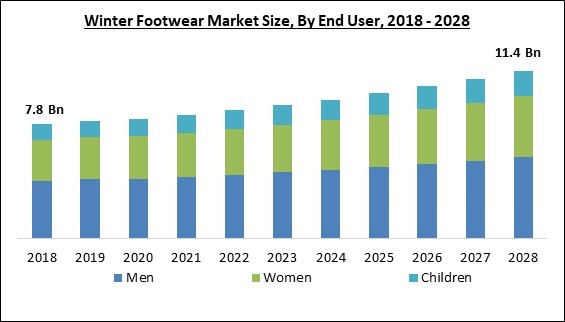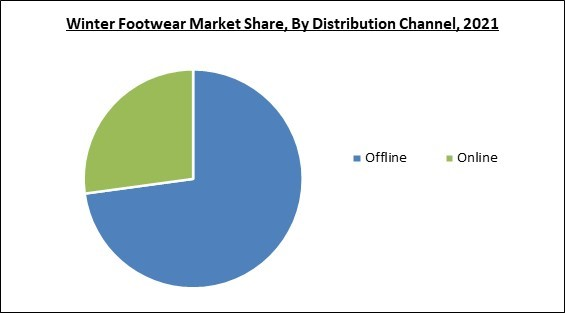The Global Winter Footwear Market size is expected to reach $11.4 billion by 2028, rising at a market growth of 4.6% CAGR during the forecast period.
Winter footwear is typically worn on the feet, protecting against environmental dangers such as temperature fluctuations and abrasion from uneven terrain. Thus, winter footwear, such as shoes, boots, and sandals, serves largely to enable movement and prevent accidents. In addition to being used for fashion and adornment, footwear can reveal a person's social status or rank. Socks and other hosiery are sometimes worn in conjunction with such footwear for additional comfort and relief.
Consumers around the world must be able to withstand the physiological restrictions caused by frigid temperatures. Utilized in colder climates, winter boots that are warm, waterproof, vapor permeable, and dry can effortlessly withstand the physiological limits imposed by cold weather. Moreover, carelessness in cold weather might be detrimental to one's health. In addition, if a person is physically strong and healthy, their body can better withstand the physiological constraints of cold weather.
These, which frequently accept the physiological limits imposed by cold weather with relative ease, impact people who already have a health problem and rise throughout the winter. As body temperature decreases, blood flow is focused in the center of the body, resulting in an increase in blood pressure and an increased burden on the heart.
When it is cold, the body uses more energy to generate heat to maintain body temperature. Activity-induced increases in heart rate and blood pressure, as well as the cold's effect of constricting arteries to lessen blood supply, are especially dangerous for the elderly, those with heart or circulation problems, and people unfit from a sedentary lifestyle and unaccustomed to vigorous exercise. Consumers require winter clothing and footwear due to the region's cold climate and desire for warmth. As a result, the winter footwear market is predicted to grow throughout the forecast period.
The market research report covers the analysis of key stake holders of the market. Key companies profiled in the report include SOREL Corporation (Columbia Sportswear Company), Wolverine World Wide, Inc., Deckers Outdoor Corporation, Airwair International Ltd. (Dr. Martens) (Permira), Nike, Inc., Rocky Brands, Inc., Danner (ABC Mart Korea Co., Ltd.), Norse Projects, Amer Sports, and New Balance Athletics, Inc.
Winter footwear is typically worn on the feet, protecting against environmental dangers such as temperature fluctuations and abrasion from uneven terrain. Thus, winter footwear, such as shoes, boots, and sandals, serves largely to enable movement and prevent accidents. In addition to being used for fashion and adornment, footwear can reveal a person's social status or rank. Socks and other hosiery are sometimes worn in conjunction with such footwear for additional comfort and relief.
Consumers around the world must be able to withstand the physiological restrictions caused by frigid temperatures. Utilized in colder climates, winter boots that are warm, waterproof, vapor permeable, and dry can effortlessly withstand the physiological limits imposed by cold weather. Moreover, carelessness in cold weather might be detrimental to one's health. In addition, if a person is physically strong and healthy, their body can better withstand the physiological constraints of cold weather.
These, which frequently accept the physiological limits imposed by cold weather with relative ease, impact people who already have a health problem and rise throughout the winter. As body temperature decreases, blood flow is focused in the center of the body, resulting in an increase in blood pressure and an increased burden on the heart.
When it is cold, the body uses more energy to generate heat to maintain body temperature. Activity-induced increases in heart rate and blood pressure, as well as the cold's effect of constricting arteries to lessen blood supply, are especially dangerous for the elderly, those with heart or circulation problems, and people unfit from a sedentary lifestyle and unaccustomed to vigorous exercise. Consumers require winter clothing and footwear due to the region's cold climate and desire for warmth. As a result, the winter footwear market is predicted to grow throughout the forecast period.
COVID-19 Impact Analysis
The COVID-19 pandemic has had a detrimental impact on the market for winter footwear, as many governments have implemented lockdowns to prevent the spread of the disease. As a result, the bulk of manufacturing facilities and operations were either temporarily or permanently shuttered, halting production for various businesses. In addition, trade restrictions drastically disrupted supply chains. In addition, other government agencies issued instructions and imposed travel prohibitions, which resulted in the cancelation or delay of many sporting events and activities. In addition to reducing the need for winter footwear, the laws enacted to prevent people from going outdoors unnecessarily reduced the demand for winter footwear.Market Growth Factors
Growing urbanization resulting in grown number of footwear brands
Growing urbanization in developing nations is a major factor driving the demand for winter footwear, such as snow boots. Increasing urbanization has allowed designers and producers to connect with their target market more precisely and to understand their demands and the latest fashion trend. As a result, there was an increase in demand, particularly amongst college students and employed women, who are considered more fashion-focused and carry more sophisticated clothes. In addition, the increase in the number of women in the labor force will also raise the demand for different types of footwear.Less expensive shoes being marketed by manufacturers to expand reach
Snowshoes, once considered a premium item in North America, Europe, and Japan, have gained immense popularity in recent years yet are still regarded as niche products. As a result, Snowshoe makers are moving into new markets like China, India, and Latin America to boost their consumer base and sales potential. Technology has enabled manufacturers to construct snow shoes out of lighter, more flexible materials and with features that enhance the snow removal process, such as shock absorption, waterproofing, and grip. Formerly, snow shoes were composed of heavy, expensive materials. These elements would support the growth of the regional market.Market Restraining Factor
Concerned health problems related to misfit footwear
The most typical consequence of wearing uncomfortable shoes could be ankle pain. Frequently, people walk in a manner that is unnatural for their bones, resulting in highly sore ankles. The most apparent effect of improperly suited shoes is joint discomfort caused by persistent pressure on the joints. In addition, certain boots lack adequate cushioning, which forces the user's joints to absorb all shocks, which might result in foot pain. Thus, the negative impacts on the foot and physical health of the wearer can discourage individuals from wearing winter footwear such as boots, thereby impeding market expansion.Type Outlook
Based on type, the winter footwear market is segmented into boots, shoes and others. In 2021, the boots segment held the highest revenue share in the winter footwear market. The boots segment includes several types of footwear such as desert leather boots, snow boots, tactical boots, and labor boots. When hiking over snow and ice, winter boots keeps the feet warm and dry along with providing exceptional traction. In addition, their tall top, insulation, and unique non-slip soles set them apart from conventional winter footwear.End-user Outlook
On the basis of end user, the winter footwear market is fragmented into men, women, and children. In 2021, the men segment dominated the winter footwear market with the maximum revenue share. Men's winter footwear is growing in popularity due to expanding male engagement in sports including such mountain biking and increasing demands for high-end, comfortable footwear. In addition, the desire for trendy footwear like combat boots, chukka boots, and cowboy boots has increased the market for men's winter boots. Owing to the rise of males in corporate occupations, professions, and sports around the world, nearly all men wear winter formal footwear.Distribution Channel Outlook
By distribution channel, the winter footwear market is classified into online, and offline. In 2021, the online segment garnered a significant revenue share in the winter footwear market. This is owing to the advantages that the internet market provides to consumers. Every day, an increasing number of consumers are attracted to the platform by the benefits of online shopping, which include the ability to purchase items from anywhere and at any time, the absence of payment risks, and the availability of special deals. In addition, the rise of digitization has contributed to the platform's expansion, hence fostering the expansion of a market in this segment.Regional Outlook
Region wise, the winter footwear market is analyzed across North America, Europe, Asia Pacific and LAMEA. In 2021, the Europe region led the winter footwear market by generating the highest revenue share. With the aim to remain in a competitive sector, companies have been influenced by the increasing penetration of winter footwear on the European market to create innovative new designs. In addition, by using well-known sportsmen to represent their brands, manufacturers of winter footwear in Europe are increasing brand awareness.The market research report covers the analysis of key stake holders of the market. Key companies profiled in the report include SOREL Corporation (Columbia Sportswear Company), Wolverine World Wide, Inc., Deckers Outdoor Corporation, Airwair International Ltd. (Dr. Martens) (Permira), Nike, Inc., Rocky Brands, Inc., Danner (ABC Mart Korea Co., Ltd.), Norse Projects, Amer Sports, and New Balance Athletics, Inc.
Scope of the Study
By Type
- Boots
- Shoes
- Others
By Distribution Channel
- Offline
- Online
By End-user
- Men
- Women
- Children
By Geography
- North America
- US
- Canada
- Mexico
- Rest of North America
- Europe
- Germany
- UK
- France
- Russia
- Spain
- Italy
- Rest of Europe
- Asia Pacific
- China
- Japan
- India
- South Korea
- Singapore
- Malaysia
- Rest of Asia Pacific
- LAMEA
- Brazil
- Argentina
- UAE
- Saudi Arabia
- South Africa
- Nigeria
- Rest of LAMEA
Key Market Players
List of Companies Profiled in the Report:
- SOREL Corporation (Columbia Sportswear Company)
- Wolverine World Wide, Inc.
- Deckers Outdoor Corporation
- Airwair International Ltd. (Dr. Martens) (Permira)
- Nike, Inc.
- Rocky Brands, Inc.
- Danner (ABC Mart Korea Co., Ltd.)
- Norse Projects
- Amer Sports
- New Balance Athletics, Inc.
Unique Offerings
- Exhaustive coverage
- The highest number of market tables and figures
- Subscription-based model available
- Guaranteed best price
- Assured post sales research support with 10% customization free
Table of Contents
Chapter 1. Market Scope & Methodology
Chapter 2. Market Overview
Chapter 3. Global Winter Footwear Market by Type
Chapter 4. Global Winter Footwear Market by Distribution Channel
Chapter 5. Global Winter Footwear Market by End-user
Chapter 6. Global Winter Footwear Market by Region
Chapter 7. Company Profiles
Companies Mentioned
- SOREL Corporation (Columbia Sportswear Company)
- Wolverine World Wide, Inc.
- Deckers Outdoor Corporation
- Airwair International Ltd. (Dr. Martens) (Permira)
- Nike, Inc.
- Rocky Brands, Inc.
- Danner (ABC Mart Korea Co., Ltd.)
- Norse Projects
- Amer Sports
- New Balance Athletics, Inc.










